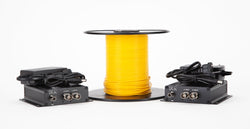IP Vs CCTV
IP or CCTV Video Applications Which to Choose and Why?
The use of video surveillance has become a significant part of just about every facet of our lives. The question many times is not "are we going to put video surveillance in" but "how are we going to do it?", and which method of transmission is the best for our specific needs.
In general, those who need to monitor events in realtime are choosing IP monitoring solutions. These solutions allow for transmission of both full-motion and still images over LAN networks via the internet. Businesses who wish to be able to keep an eye on employees and customers in real time, and anyone who wants to be able to log onto any computer at any time and know what is going on at their business choose the "Internet Protocol" solution. This type of solution is also being chosen for applications where real time images of an emergency in progress are important. Police cars and emergency vehicles would be candidates for this type of network.
Also, costs of an "Internet Protocol" visual network can be reduced if the appropriate networking equipment infrastructure is already in place. Plus, your network diagnostic tools should be able to effectively pinpoint any trouble spots within the system.
Monitoring your system using an"Internet Protocol" solution however does require a large amount of bandwidth, and network speeds need to be fast. Fiber Optic LAN equipment is capable of fulfilling these requirements. VERSITRON has several types of fiber optic switches and fiber optic media converters which have proven popular with proponents of this type of monitoring. View an "Internet Protocol" Visual Monitoring Networks design.
Those who have chosen an analog CCTV system and who are also using DVRs, have eliminated the "burdensome storage" tape issues which has been one of the leading disadvantages of analog "closed circuit television". Instead, they have taken into account that separate links that are not tied into a network can actually provide more reliability. They have asked themselves: What happens when the network goes down? What happens if the internet itself is down for a time? Or, they may have an area where low light is a factor. "Internet Protocol" monitoring networks are not as successful in low light areas unless the cameras are "piggy-backed" on the conventional PAL/NTSC resolution. View all "Closed Circuit Television" System Design.
Fans of analog "Closed Circuit Television" Converters appreciate the consistent frame rates that look more like real life. They also like the fact that analog "closed circuit television" has one standard of transmission, PAL or NTSC depending on their location. Time spent figuring out which "Internet Protocol" cameras work with which visual recording solution is eliminated. Lastly, for others, network speed is critical. They therefore choose separate cable for their visual monitoring surveillance solutions in order to keep their data network speeds at optimum levels.
Whichever option you choose, VERSITRON is ready to help.
Recommended Products

10/100/1000Base-T to 1000Base-SX/LX "Triple Duty" Gigabit Media Converter with SFP GBIC Technology
M7260A
View Details
PoE+ Gigabit Industrial Media Converter | 1-RJ45 Ethernet Port, 1-SFP Fiber Port
MF7260P
View DetailsSpecial offer
Testimonials
"I couldn't be happier with the equipment or the service you gave me during our 'rush' to deploy."
"It's working perfectly and has since the day we first connected the fiber."
"I'm pleased both with the product and probably more so with the people behind the product!"







